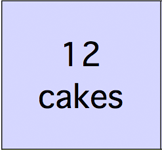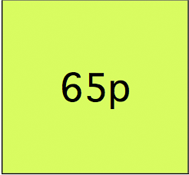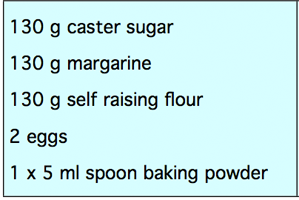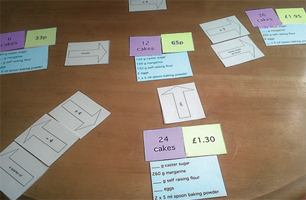Or search by topic
Number and algebra
Geometry and measure
Probability and statistics
Working mathematically
Advanced mathematics
For younger learners
Tray Bake



- Problem
- Student Solutions
- Teachers' Resources
Why do this problem?
This is one of a series of problems which students might encounter in Food Technology.The problem originated in a discussion with Food Technology PGCE students, who said that scaling recipes is something many students find difficult and which can be challenging for the FT teacher to help them with.
Mathematically, this problem gives practice in calculating proportions and ratios.
Possible approach
Note: the basic recipe is for 12 cakes (which is why the cost of 6 cakes is 33p - no half pence any more).
Start by laying out the three cards below in a group (they come from this set of cards, one mauve for the number of cards, one turquoise for the recipe, and one green with the cost of the ingredients):



Explain that this is the basic recipe, the number of cakes it will provide and the cost of the ingredients, without any extras.
Now pull out any one card from the rest of the cards and lay it out by itself. Then lay out all the rest of the cards face up and ask the students to find the other two that go with your single card. You should end up with a second group of 3 cards, a mauve one for the number of cakes, a turquoise one for the recipe, and a green one for the cost of the ingredients. Point out that some of the quantities in the recipe are missing - can they supply the missing information?
Then lay out the arrow cards. Students should choose as many of these as they can to connect the two groups of cards, making sure the arrows are pointing the right way. Ask if they can think of other connections, using words or numbers, and get them to fill in blank arrows.
Students should then be ready to work in small groups, grouping the cards and using arrow cards (either those provided or their own ideas on the blank arrows) to connect the groups of cake cards. They should ensure that everyone in the group understands the placing of all cards and arrows and agrees them - if they don't all understand or agree, they should discuss the problem, not just
move on.
 The photo shows what work in progress might look like.
The photo shows what work in progress might look like.
Key questions
- Can you all explain how you've grouped the cards and connected them with arrows?
- Is there a number of cakes which acts as a unit or basis for the other calculations?
- Are there any arrows provided which you haven't used yet? Could you use them?
- Are there any arrows provided which you can't use at all? If so, why not?
- Could you put some of your arrows in different places between the groups and still have a correct arrangement?
- Are there arrows which are equivalent?
Possible extension
Can you scale the recipe for 50 cakes, 100 cakes, any number of cakes?Possible support
Since all the numbers of cakes are divisible by 6, 6 cakes may be a good unit to focus on, rather than going for the unitary method (focusing on 1 cake) immediately.You may also like
Rule of Three
If it takes four men one day to build a wall, how long does it take 60,000 men to build a similar wall?
How Big?
If the sides of the triangle in the diagram are 3, 4 and 5, what is the area of the shaded square?

